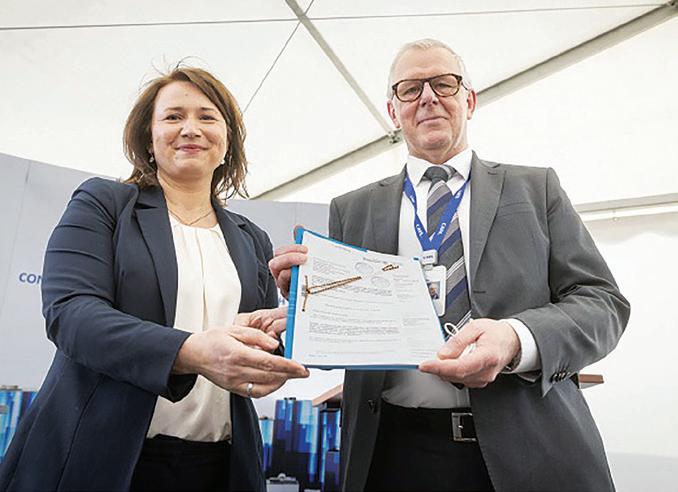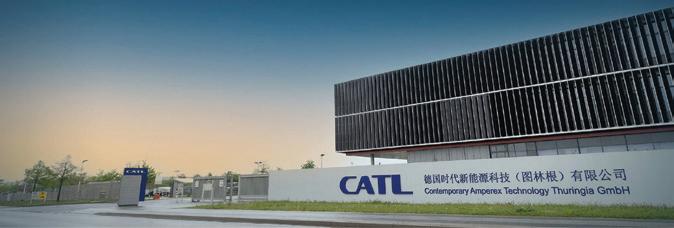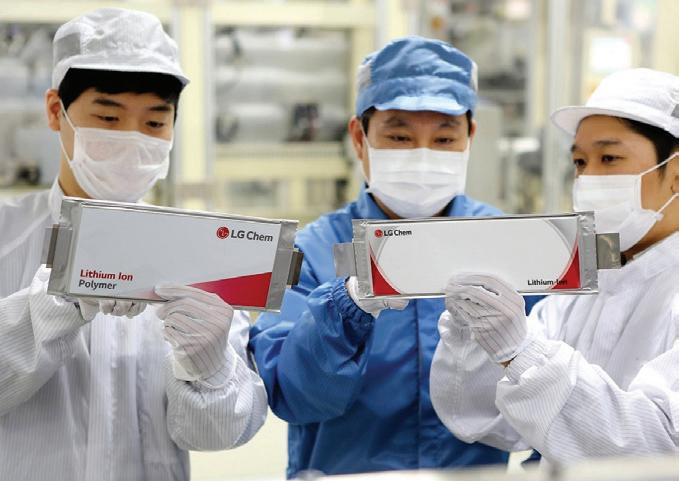
10 minute read
THE CHINA PERSPECTIVE
from ELBC Showguide, 2022
by hamptonhalls
Despite the EU’s oft-stated goal of building a battery cells manufacturing network to challenge Asia’s dominance, a senior Beijing envoy to Germany tells Batteries International, China is happy to play a key supporting role in shaping Europe’s batteries future.
How China’s battery tigers are helping Europe’s nascent battery industry roar
Many of the draft rules soon to become EU law under the Batteries Regulation are part of an undisguised effort on the part of the bloc’s leaders to dethrone Asia from its dominance in the batteries market.
Measures imposing tough ‘green criteria’ seeking to make European battery products an international standard and setting carbon emission limits on production are part of the arsenal of policies the bloc has crafted, in an attempt to allow Europe’s own gigarevolution to pick up speed and so challenge dominance from battery makers in countries such as China and South Korea.
But while the policy-making rumbled on, Asia’s battery tigers prowled into town. The ‘competitors’ are no longer across the other side of the world — they’re busy at work in EU member states.
And in exclusive interview with Batteries International, the commercial counsellor at China’s embassy in Berlin, Wang Weidong, says his nation is happy to be supporting Europe’s green energy agenda.
As far as the Batteries Regulation is concerned, Wang says Chinese battery companies believe the new rules will have a positive impact in “promoting green, low-carbon and sustainable development” of the battery industry and tackling climate change.
Key players in China’s battery industry are among others, such as South Korea, who have been busy setting up shop in the EU — in partnership with European peers — and in some cases benefiting from generous EU financial incentives.
Wang says data from the federal government-backed Germany Trade and Invest (GTAI) shows that around 5,700 Chinese firms across a variety of sectors were active in Germany in 2021, which in turn employed a total of more than 103,000.
And despite what Wang said were difficult economic conditions, GTAI data on foreign direct investment for Germany in 2020 indicated some 170 greenfield investment projects from China — a 10% increase over the previous year.
Those investors include Chinese battery manufacturing majors Contemporary Amperex Technology (CATL) and SVOLT Energy Technology. “They specialize in electromobility and are building battery manufacturing factories in Germany,” Wang says.
Meanwhile another Chinese battery titan, Narada Power, ploughs ahead with its range of projects in support of strengthening Germany’s power grid.
Wang says all three companies “are examples of China’s integration into the world economy and the result of the globalization of the (batteries) value chain.
“With China’s opening-up process and economic growth, Chinese companies are increasingly expanding their global presence,” he says. “Decisions to enter the German and European markets are made by Chinese investors based on business interests, just like German companies in China.”
And now that Chinese battery companies and others have become interwoven into the commercial fabric of Europe’s industrial landscape, Wang hopes Chinese companies “will be offered fair competitive conditions here and that they can be treated equally with local companies”.
“It is conceivable that Sino-European exchanges in the methodology of battery products will be undertaken and a cooperation mechanism will be established … “This should facilitate mutual market access, create a win-win situation and make constructive progress towards global climate
protection” — Wang Weidong

In terms of the growth and technological impact of Chinese battery businesses in Europe, Wang says that while Narada has been involved in lead acid and lithium ion battery technology for more than 20 years, “lithium batteries have gradually become the core product” of the firm’s product portfolio in recent years.
Since 2017, Narada has been working with German partner companies to develop and deploy battery energy storage projects with a total capacity of 75MW/125MWh. These lead carbon ESS projects have been implemented in five phases, each with an output of 15MW/25MWh.
Narada has also established a European Energy Storage Service Center in Germany from which it offers services to European customers.
In addition, Wang says the company has provided batteries for frequency control storage projects with a capacity of 50MWh commissioned in Ireland, while a grid peak regulation 300MWh storage project is scheduled for delivery in Italy by the end of 2022, according to Wang.
In future, Narada’s focus will be on the “core business of intelligent energy storage and on lithium batteries”.
CATL also sees “great development potential” for lithium battery technology. “Breakthroughs in their performance, such as energy density, range, safety, service life and charging have been achieved.”
“At the same time, new products and business models are appearing from CATL such as cell-to-pack and cell-tochassis, such as CTP,” Wang says.
“The innovation of battery industry depends on the development of key technologies, but market acceptance also plays a crucial role.”
In early April, Contemporary Amperex Technology Thuringia (CATT), the group’s first manufacturing plant built outside China, received approval for an initial plant capacity of 8GWh per year.
Wang says: “The construction of the plant, which is also CATL’s first battery factory in Germany, is in the final phase and the installation of the machines are in full swing, so that the first cells can roll off the assembly line at the end of 2022.”

Anja Siegesmund Thuringia minister of environment energy and nature conservation and Matthias Zentgraf CATL Europe president

CATL’s Thuringia plant in Germany: ready for action by the end of the year
HOW REALPOLITIK ENERGIZED THE GREEN ENERGY AGENDA
Since the launch of the European Battery Alliance in 2017, the European Commission has trumpeted calls to make the bloc a world leader in sustainable battery production.
In doing so, Europe has not been shy in dishing out billions of euros to build a home-grown battery cells manufacturing network in its quest to slap down Asia’s dominance in the market.
However, politics make strange bedfellows. While the EU sought to invest in building its own batteries empire, it was revealed in July 2018 that Germany would unlock the coffers of an economic aid fund — to support CATL’s construction of a battery cells factory in the country.
The agreement was announced during talks between Germany’s then chancellor Angela Merkel and Chinese premier Li Keqiang. Officials said the financial support was allowed under EU guidelines for regional investment.
It’s also been barely two years since European Commission vice president and champion of the Battery Alliance, Maroš Šefcovic, said in a speech to a Nordic Battery Scene webinar that reducing Europe’s “overdependence on third countries, both for batteries and the raw materials needed to make them, is crucial to boosting our strategic autonomy and resilience in this area”.
In that June 2020 speech, Šefcovic bemoaned the fact that “73% of the batteries bought in the EU are made in China, and only 6% in Europe”.
Today, those remarks can perhaps be better revised to say: “We don’t mind buying batteries from Chinese companies, so long as they’re made in Europe.”
Realpolitik in action, no doubt.
With a total investment of €1.8 billion (about $1.9 billion), CATL intends to expand production capacity to 14GWh and create 2,000 jobs in Germany. “CATL is therefore bringing its state-of-the-art technologies to Europe,” says Wang.
According to Wang, the spirit of industrial cooperation in the batteries sector should also be a model for governments to work together in using technology to tackle climate change.
“It affects us all and can only be mastered through our joint efforts. China has committed to peak carbon emissions by 2030 and become carbon neutral by 2060. Germany and Europe have also set themselves an ambitious goal for climate neutrality,” he says.
“To achieve that goal, both Europe and China are trying to expand renewable energies. Energy storage is an essential technical component for the energy transition. The low-carbon transformation and the innovations in climate protection technologies, which include energy storage, therefore hold great potential for cooperation between China and Germany.”
Wang says Chinese president Xi Jinping and German chancellor Olaf Scholz agreed during a video conference on May 9 that both sides would “deepen cooperation on climate protection and energy transformation”.
The incoming Battery Regulation “clarifies binding requirements on carbon footprints, due diligence, material recycling targets, labelling and information management,” he says.
“With the rapid technological innovation in this industry and the globalization of the supply chain, it is desirable that international coordination of the production standards in the battery industry be strengthened.
“China and Europe are the world’s most important regions of production and consumer markets for new energy vehicles and power batteries,” says Wang. “German electric vehicles equipped with Chinese power batteries are sold all over the world.”
Wang also hints at a desire to work closely with Europe in advances in next generation battery technology, saying it is “conceivable that Sino-European exchanges in the methodology of battery products will be undertaken and a cooperation mechanism will be established.
“This should facilitate mutual market access, create a win-win situation and make constructive progress towards global climate protection.”
However, Wang says that as world economies seek to pick up pace in the aftermath of the pandemic there are still challenges ahead. He acknowledges that for all China’s economic and industrial might, it too is not immune from global events.
“There are disruptions in the global supply and transport chains, which can be observed in many countries. The reasons for this situation are manifold: bottlenecks in container shipping, rising commodity prices and so on,” he says.
What Wang terms as the “current Ukraine crisis” has, he says, “further aggravated the situation.
“China is now also being negatively affected. For example, like in Germany, in China there is a shortage of chips for the automotive industry.”
Wang is also open about the impact of a fresh outbreak of Covid cases in China in recent months that has led to some companies temporary halting production.
But, conscious of China’s role as a global player in the materials supply chain for a range of industries, Wang says the government issued new Covid-19 prevention guidelines, designed to enable businesses to “resume work to secure and stabilize industrial supply chains.
“In 2021, China’s exports increased by 21.2% year-on-year. In doing so, China has helped meet the manufacturing and living needs of other parts of the world and helped to sustain the global industrial and supply chain. We will continue these efforts in the future.”
ASIA’S BATTERY DRIVE INTO EASTERN EUROPE

A number of Asian battery players are making inroads into the European battery cells manufacturing market.
In December 2020, the Hungarian government said Chinese lithium battery components company Shenzhen Kedali Industry would open a manufacturing base in the north of the country.
In July 2021, the European Commission approved a proposed €90 million ($94 million) subsidy by Hungary for construction of a second electric vehicle battery plant in the country by South Korea’s SK Innovation.
The announcement came after SKI secured a $500 million ‘green loan’ from the Export-Import Bank of Korea towards construction of the facility — and unveiled plans to start building a third battery plant in Hungary.
On March 18 this year, the European Commission approved a €95 million package of aid offered by Poland’s government to support the LG Chem group’s expansion of its EV battery cells production plant in the country.
Commission executive vice president Margrethe Vestager, in charge of competition policy, said an investigation into the incentives offered confirmed that the expansion “will contribute to job creation and to the economic development of a disadvantaged region, without unduly distorting competition”.
PrecisionPastingFibers CoveringTheGlobe
Consistencyyoucancounton...since1938
•Specializedverticalcuttingprocess •Newhighvolumecapacityproductionfacility •Modernstateoftheartproductionandlabfacilities •Allfiberstypesavailable •Worldwidedistributionandsupplybase •ISO 9001:2015


1515ElmwoodRd. Rockford,Il61103USA Tel:815-964-8619 Fax:815-964-7949
www.cellusuede.com
Meet the team
Bringing the industry together www.batteriesinternational.com
Karen Hampton, publisher
Antony Parselle, page designer Mike Halls, editor
Juanita Anderson, business development manager John Shepherd, deputy editor
Hillary Christie, reporter
Jade Beevor, advertising director
Kevin Desmond, historian
PUBLISHER
Karen Hampton
Tel: +44 (0) 7792 852 337 karen@batteriesinternational.com
EDITOR
Mike Halls
+44 (0) 7977 016 918 editor@batteriesinternational.com
DIGITAL MEDIA OPPORTUNITIES
Jade Beevor +44 (0)1243 782 275 jade@batteriesinternational.com




